If you have a dog with hair that grows (as opposed to fur that sheds), long-term cruising adds one more skill you need to learn: DIY grooming.
When we’re in a good-sized town, we try to find a groomer – we usually manage to do this two or three times a year. But sometimes, such as now in Marathon, there are few local groomers and there is a 2+ month wait for an appointment if you’re not already on the client list. So we have to do it ourselves. Ditto for times when we’re in remote places. We’re not trying to make her look ready for a dog show, just a practical cut for life as a boat dog.
Paz is an unknown mix, but most likely a combination of poodle, bichon and possibly Maltese. Years ago, I got a set of inexpensive “people” hair clippers and tried to use them on her very thick curly hair. It just didn’t work. So I used a pair of 4” scissors for several years . . . it worked, but it took forever and, I’ll admit, it looked like a hack job. A slicker brush, recommended by our Mexican vet, was used on the tangles – and if she got a bad one, I’d just cut it out (which contributed to the hack job appearance).
Since then, various professional groomers and other cruisers with “poodle-y” dogs have taught me about a number of tools to make grooming much easier. Paz looks better, too.
First off, if you are actively cruising in more remote areas and taking the dog ashore on beaches, paths and so on, the grooming challenge is going to be tougher than when living in a house and walking on sidewalks. Paz picks up dirt and sand, every imaginable kind of burr, sticker and thorn . . . not to mention her penchant for rolling in sand and mud and wading in salt water. Burrs and mats occur on a daily basis.
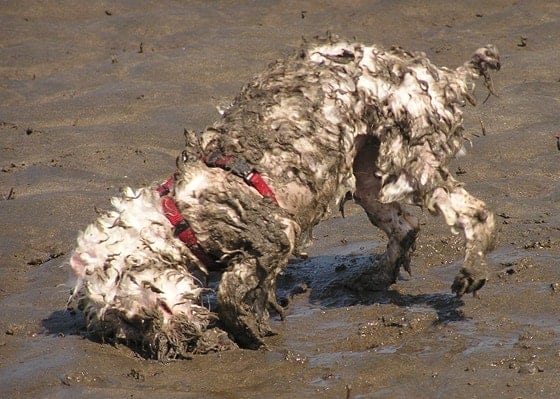
So before discussing the grooming tools I use, a few things I’ve learned in general:
- Keeping the hair very short on the dog’s feet – a good 2” up from the ground and around the pads – helps a LOT with burrs. Anytime your dog refuses to walk, check for burrs in the paws.
- Short hair on the butt and around the genitals (where they sit on the ground) will help avoid burrs and dirt in those areas.
- In general, shorter hair on the body makes for less tangles but don’t make it so short that the skin gets sunburned (yes, dogs get sunburn).
- A small sprayer, such as the Aquabot that I use, is an easy way to rinse mud or salt water off before coming aboard the boat – and it’s good for baths, too. (Note: the Aquabot is frequently unavailable on Amazon. CoreGear makes one that is similar.)
Admittedly, these things may not be totally in line with the typical grooming for your breed of dog, but it will make it much easier on your dog and yourself.
BRUSHING
For everyday brushing, I’ve found four tools that work much better than the old slicker brush (I use all four and got them from Amazon):
- Tangle Teezer – yep, it’s a “people brush” that is much more gentle on the tangles and mats that occur when Paz is in and out of the water. This is my most-used tool.
- Mane & Tail Detangler – again, a “people product” albeit one that was developed from show horse products. Spray it on stubborn tangles before using the comb below. It helps but it also tends to pick up dirt on paws . . . (Dave also uses this on his long curly hair and swears by it)
- Evolution Comb with rotating teeth – useful to comb out places I can’t get to with the Tangle Teezer and for small mats. Somehow, the rotating teeth makes the comb go through “clumps” much more easily. With this and the dematting comb, there are far fewer mats that have to be cut out.
- De-Matting Comb – the teeth on this have a sharpened inside edge which will cut through nastier tangles although it will tug some on the dog’s skin; Paz doesn’t find it objectionable for most mats. If she does object, that’s my signal to cut out a mat instead of trying to work it out. More often, when she’s in a “change of coat” stage, this will easily remove the undercoat that is matting and tangling with burrs – by using this brush regularly at such times (generally twice a year) there are far fewer problems.
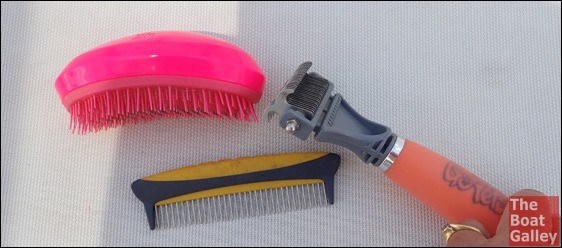
SCISSORS
Whether for cutting mats out or trimming around eyes and mouth, a pair of scissors is essential. I much prefer to use small, rounded tip (aka blunt tip) scissors with a sharp blade. To me, blunt tips are just a whole lot safer when working around a dog that moves!
These Fiskars scissors aren’t expensive, but I label them with a Sharpie as being for Paz only – using them on other things will dull the blades (we keep a second pair in a different color as utility scissors). I got mine at Walmart; tons of places sell them or you can get them on Amazon (note: they are right-handed and officially “kids” scissors but my fingertips fit and the blades are quite sharp):
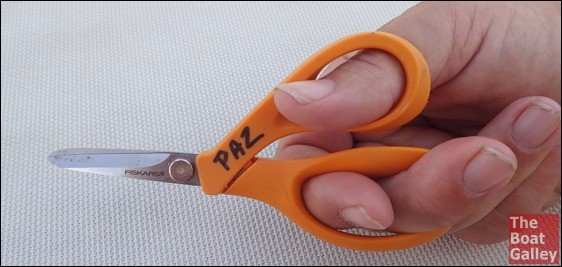
HAIR CUTS
Good clippers make a huge difference! First off, you’ll need sufficient battery capacity and an inverter to run the clippers (a generator would also work or maybe you could find power ashore). Clippers do NOT require a pure sine wave inverter (but it’s fine to use one).
“People” hair clippers simply won’t go through most dogs’ hair. And dog clippers aren’t cheap by the time you get a couple of blades and lubricant. But getting good ones will pay off in the long run, both in making hair cuts easier on you and the dog and in dollars saved when you’re in the land of $50 or more dog grooming!
IMPORTANT: Cut your dog’s hair when it’s CLEAN and DRY. I usually give her a bath late one day (I used Johnson’s Baby Shampoo so it doesn’t sting her eyes) and then clip her the next day. DO NOT use the clippers if salt water has dried on the hair – it will be a sticky mess! Even just a bunch of dirt will clog clipper blades. And never use electric clippers on a wet dog.
Below, I’ve listed the clippers and blades that we use on Paz. You might want to check with your current groomer to see what blade lengths they use on your dog now – but my advice is to get one fairly short blade for those “close trim” areas I mentioned above (the Andis clipper comes with one). I got all the items below from Amazon:
- Andis UltraEdge Clipper (comes with a #10 close blade) – recommended by two groomers I spoke with as well as two cruisers. Has a 14’ cord. Has worked well for us – Andis has some good YouTube videos about using the clippers, maintaining them and clipping a dog’s hair.
- Andis extra blade for the body (we use a 1/2” blade on Paz – overall, it’s a good length for most dogs) – numerous blade lengths are available at this link
- Andis lubricating oil – basic maintenance of the clippers. The clippers come with a tube of oil that will last 6-ish months; then buy this.
- Andis Cool Care Plus – it’s a blade lubricant, coolant, disinfectant and rust preventive. Spray the blade with it several times in the course of a haircut; doesn’t take the place of the lubricating oil but is used in addition. NOTE: part of the Amazon description is messed up, this link is only the Cool Care Plus spray.
I use an old toothbrush to clean hair out of the blades after every haircut. The Andis owners manual shows you how to do this – it’s easy and you don’t need to buy a special brush.
We don’t use any sort of tether or “head and haunch holder” – in inexperienced hands (mine!) they seem too much like a noose if the boat were to rolls and Paz slide. Instead, I use one hand with the clippers and one hand under her tummy or wherever works best; sometimes Dave helps a bit with steadying her. Sometimes if Paz just gets too fed up with sitting/standing still for the trimming, we stop for the day and finish up at another time. In general, though, she’s very good about it!
Paz is much happier about the haircut if she has a secure place to sit or stand. We do it in the cockpit to make clean up easier. I’ve learned to put one of my non-slip kitchen mats or an old towel down for her to stand or lie on – this made a huge difference in how antsy (or not!) she gets. Feeling steady on her feet has made it MUCH easier for both of us. (Note these are the same mats I bought for drying dishes – I love dual purpose items):
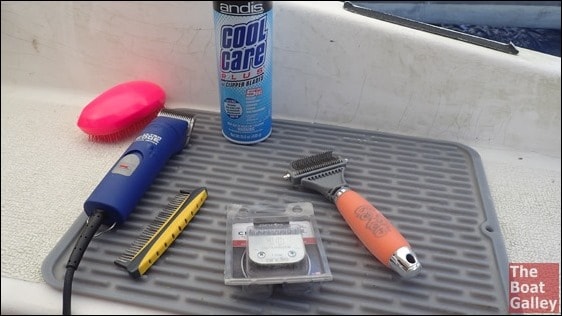
By the way — have a good brush and dust pan and/or hand vacuum cleaner to clean up when the cut is done!
OTHER
If you don’t already have them, you’ll also need nail clippers (check with your current groomer as to what works best on your dog’s nails; we use an old guillotine-style pair) and doggie toothpaste (Paz is too small to use a toothbrush, I rub the toothpaste on with my finger).
HARNESS
I’ve said it before, but I’ll repeat it here: using a harness instead of a collar is much safer sboard a boat. We hook Paz’s leash on her harness whenever we’re underway (with the other end attached to a cleat or other secure place). With a harness, if the boat rolls and she slides, the force is spread over her chest; with a collar it could break her neck.

Carolyn Shearlock has lived aboard full-time for 17 years, splitting her time between a Tayana 37 monohull and a Gemini 105 catamaran. She’s cruised over 14,000 miles, from Pacific Mexico and Central America to Florida and the Bahamas, gaining firsthand experience with the joys and challenges of life on the water.
Through The Boat Galley, Carolyn has helped thousands of people explore, prepare for, and enjoy life afloat. She shares her expertise as an instructor at Cruisers University, in leading boating publications, and through her bestselling book, The Boat Galley Cookbook. She is passionate about helping others embark on their liveaboard journey—making life on the water simpler, safer, and more enjoyable.
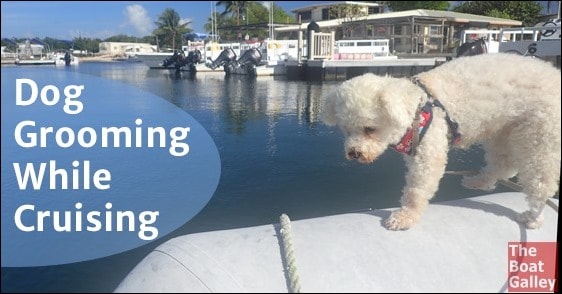
Pamela says
With a golden retriever, my most helpful grooming tip is to know where your wind is coming from. Nothing like losing your mind and having more hair blowing around your cockpit after grooming than before.
Thanks for the tips. I’ll look for the detangler. I have the feeling both Honey and I would find it helpful.
Carolyn Shearlock says
That’s true even for a small dog such as Paz!
Mike Merriman says
always brush downwind!
Mindee McGeary Cobb says
Darn, wish I could have read this about 2 days ago so I could pick up a trimmer! Tried the people trimmer once – just doesn’t work! And you’re right, scissors looks like a hack job and takes forever!
The Boat Galley says
Sorry about that . . .
Cherie Burch says
As someone who has groomed Wheaten Terriers 13 years for show while still sailing with them, I have a few tips. Remember to always use a comb on a dry coat and a brush on a damp or wet coat. This helps to keep from ripping the hair out. Even though tempting, people shampoo is not as effective as dog shampoo. Our hair is a different texture and composition than theirs. Even people “no tears” is not as no tears on dogs. A good quality dog shampoo is cheaper and works better in the long run. And usually you can get a concentrate and mix what you need which saves space. A doggie cream rinse also helps. Even though my dogs are now retired from showing, I still get shampoo and grooming spray online from Espree (no compensation, just great products). It is easier to brush with a grooming spray because it loosens matts.
A rechargeable operated Dremmel tool is great for nails while a rechargeable clipper is good for trimming around ears, winkies and under tails. You can also use it to clipper the whole dog. I still scissor my dogs’ coats. Using a good sharp grooming shears makes the job faster. I get these online from Pet Edge.
The main thing I found with “coated” dogs is to rinse or bath and comb often. It makes that two hour job every two weeks only 1o minutes every two days.
We have a Catalina 387 and at one time 3 Wheatens with a combined 35 titles in conformation and performance events.
Nanci Whitley says
Thanks Carolyn, we just returned from 5 months in the Bahamas and I could have used this advice for my Havanese. Fortunately, I found an excellent groomer in Spanish Wells, who saved my little guy from any more of my hacking.
The Journey
Palm Coast Fl
Alyce Graves says
Your article came in the nick of time for me. In three weeks we are starting our Great Loop Adventure with a Portuguese Water Dog. I have been fretting over how to deal with her grooming needs, especially since she shakes and quakes whenever grooming tools approach her. My great groomer on Cape Cod gave me some tips but the information I’ve gathered here is both dog and boat friendly.
The Aurora B
Falmouth, MA
Carolyn Shearlock says
Glad it helped! Have a great time on the Loop!
James Edgerly says
We have a schnauzer who requires grooming every 6-7 weeks at $50 a pop…yes that is a dollar/day for grooming. I bought the Andis UltraEdge clipper, 2 extra blades, oil, 2 scissors, nail clipper, comb, and a curved hemostat for ear hair. I invested around $240 (at today’s prices) almost 8 year ago. In 240 days the equipment paid for itself, and I have been saving a dollar a day for the last 2600+ days! No brainer when you run the numbers.
Sandra T says
A useful tool for cats or dogs that shed is the Furminator. It really helps us keep the undercoat to a manageable on our medium haired cat, which help keep him a little cooler in the tropics, and cuts down on (a little bit of) the fur that flies around.
peyton says
I have a mini poo mix that looks a lot like Paz. I always say his coat is like Velcro for dirt. So your tips were very helpful and I’ll buy some of the items you use ASAP. Thanks!
Mary Ellen says
My border collies have a thick undercoat and go through periodic sheds. My go to tool is a comb shaped like a rake with teeth approximately 1/4 inch apart. It pulls out the most hair in the shortest time…. and requires no charging of power supply
Mary D says
Thanks for sharing this information! We are getting ready for the cruising life including our Cavanese Holly. She is a Havanese and King Charles Spaniel mix. During this time of COVID-19 and traveling, it is time for me to learn how to care for her.